Architectural Digest

December 1993
TEXT BY Pilar Viladas
PHOTOGRAPHY BY John Vaughan
COVER: In her Art Deco Malibu residence, Barbra Streisand stands next to Tamara de Lempicka's oil Adam et Eve, 1932, and Jacques Lipchitz's bronze Woman and Gazelles, 1911-12.
[Barbra-Archives Note: Barbra Streisand's collection of Art Deco and Art Nouveau was auctioned by Christie's in 1994. The collection netted $5.8 million. According to the New York Times, “more than a third of the total, $2 million, came from a single painting, Tamara de Lempicka's 'Adam and Eve'.” The high bidder was anonymous. Streisand told the Times, “We screamed when the Lempicka price went over $1 million. I was working out with my exercise teacher and when the bidding went over the top I screamed. I paid only $135,000 for it 10 years ago.”

Why auction her treasures? Streisand said, “It's hard to let go of these beautiful things that I have loved for so many years but I want to simplify my life...I don't want to spend so much time being preoccupied with objects, and I don't want so many anymore. That's all. I just want less...It is a good feeling to use these things for a while and then pass them on during your own lifetime.” ]
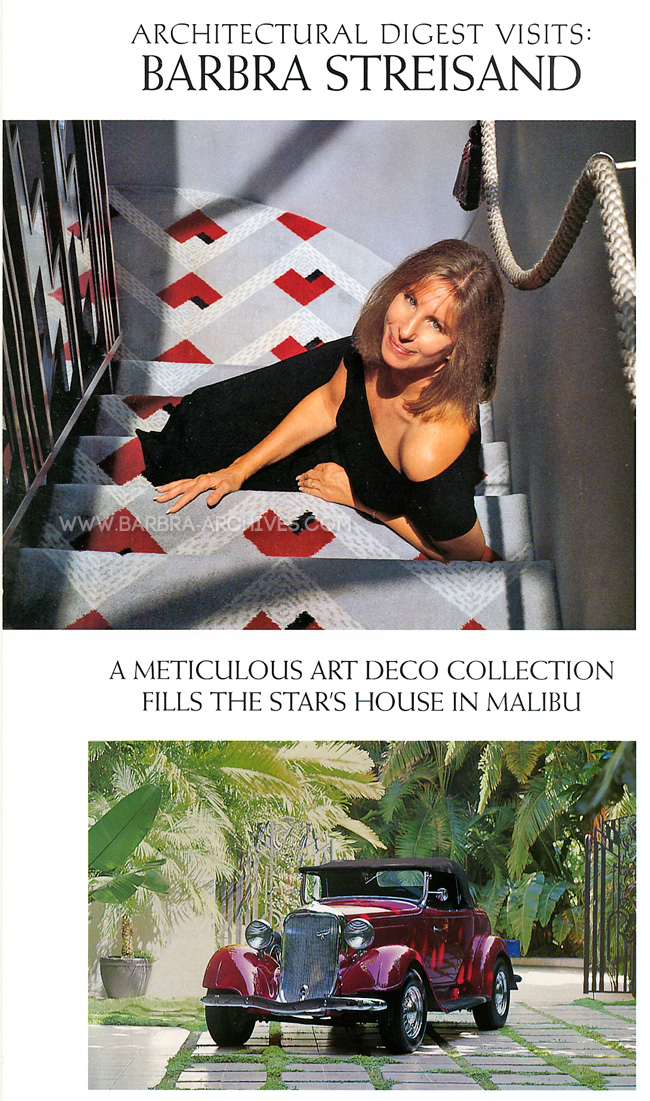
“It bothers me when the answer is 'We can't do it,'” says Barbra Streisand (above) of her four-year quest in the 1970s to re-create an Art Deco guesthouse on her Malibu compound. “I bought the 1933 Dodge because I loved Nancy Drew mysteries, and she used to ride around in a maroon roadster with a rumble seat, which this has.”
BARBRA STREISAND has been a collector her entire adult life, and then some. When the sixteen-year-old honors student graduated from Brooklyn's Erasmus Hall High School and (against the advice of her teachers and her mother) decided to forgo college in favor of acting and singing, she moved to Manhattan and set up housekeeping. Back then, she says, “I had no money to buy art, so I would buy old picture frames and put them on white walls, just framing space, which I thought was beautiful.”
But that was then. Two Academy Awards, two Emmys, a special Tony, eleven Golden Globes, eight Grammys, thirty-seven gold albums and twenty-one platinum albums (including her latest, Back to Broadway) later, this singer- actress-writer- producer- director- composer can collect anything she wants. And she has amassed enough art, furniture and decorative arts to fill a New York apartment, a house in Beverly Hills and a compound of five houses in Malibu.
Barbra Streisand goes through collecting phases during which she learns everything possible about a given style or period. As she describes it, such a project is like a movie: “It's designed as a total vision.” And with collecting, just as with movies, when she finishes one project, she moves on to the next. So to make room for new collections, she must edit what she al ready has. Moreover, she believes, “If you're not going to use something, you have to let it pass on, go on its way and live a life with somebody who will appreciate it.”
Such is the case with Streisand's collection of Art Deco, which is to be auctioned in March at Christie's in New York. The collection, which includes a good deal of Lalique glass, an inlaid-ivory desk by Emile-Jacques Ruhlmann, Tamara de Lempicka's painting Adam et Eve and clocks by Lalique, Cartier and Cheuret, has been lovingly showcased since the mid-1970s in a guesthouse/poolhouse on the Malibu property, which she meticulously remodeled in the Art Deco style, down to the doorknobs and drawer pulls. She even bought period cars—a 1926 Rolls-Royce and a 1933 Dodge—for its garage.
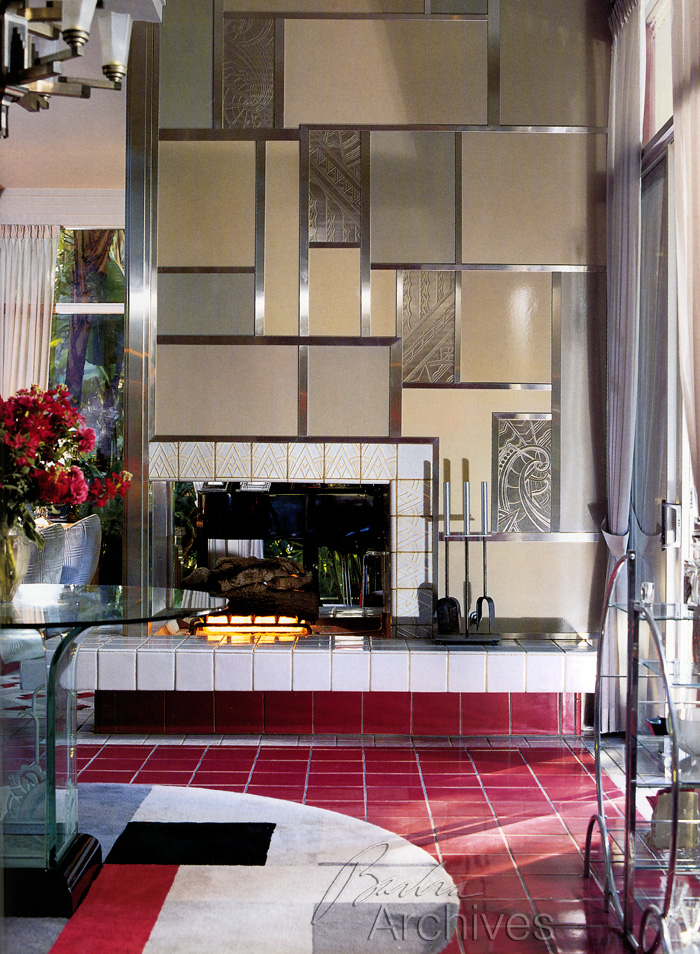
ABOVE: Panels from Los Angeles's Art Deco Richfield Building, which was demolished in 1968, were worked into a geometric grid around the living room fireplace.
Streisand is a collector with wide-ranging tastes. At the time she designed the Deco house, she was also buying, among other things, Art Nouveau pieces (stellar examples of which, such as a Tiffany spiderweb lamp and two rare Majorelle corner cupboards, are also included in the Christie's sale), and the various rooms in her residences reflected this diversity. But for the Deco guesthouse, the challenge was one of “not being eclectic,” she explains. “I thought it would be a really interesting exercise to have one theme.”
So she studied the many books and portfolios that she had gathered on the period, such as Le Luminaire, a portfolio of lighting designs that was published to coincide with the water-shed Exposition Internationale des Arts Decoratifs et Industriels Modernes, held in Paris in 1925. She pored over illustrations of decorative motifs, eventually designing several for the house's architectural details— doors, friezes and stair rails, ceramic tile patterns, rugs and even a shower curtain in one of the baths.

ABOVE: “I wanted every ceiling to be different,” says Streisand. “In the living room, the beams have that skyscraper, stepped look.” Her collection of Lalique objects includes Archers, a vase on the console table, and Jour et Nuit, a disque clock near the window. Roger de La Fresnaye's bronze Sculpture of a Woman is by the bookshelves. Stark carpet.
The living room fireplace is embel lished with a Mondrian-like arrangement of stainless-steel decorative panels that were part of the landmark Art Deco Richfield Building in downtown Los Angeles. The bedroom carpeting was copied from a 1930s Bigelow original that Streisand recalled seeing in the Huntington Hotel in San Francisco. Where original furnishings weren't used, she had reproductions or interpretations made. Given that she designed a necklace to harmonize with the house, it's no wonder that she admires architects like Frank Lloyd Wright, whose approach to design often stretched beyond the house and the furniture in it to dresses for his women clients to wear at home. “If you were an architect,” Streisand argues, “wouldn't you want to design the bronze handles? Wouldn't you want to design the floors? Wouldn't you want to design the furniture that goes into the house you built? That's the way I see things—as a complete vision.”
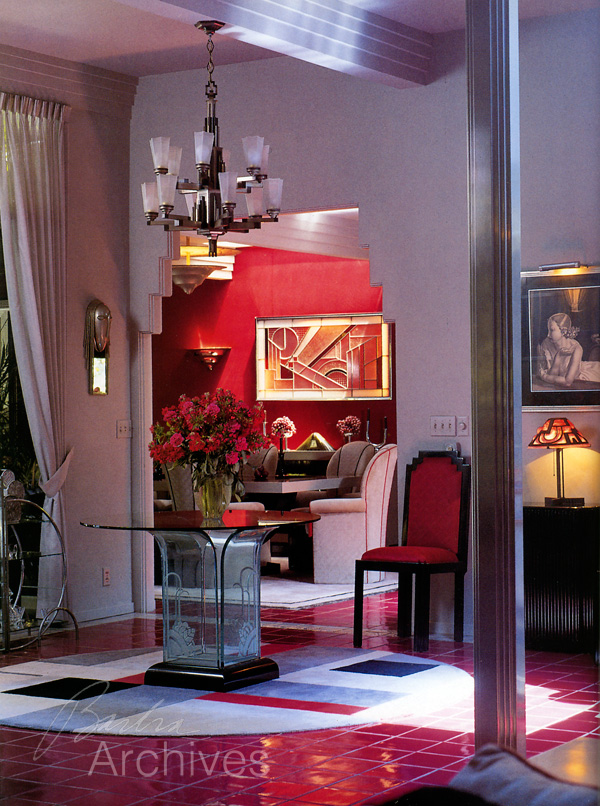
ABOVE: One of Streisand's ideas was to have tile patterns laid under the carpets that repeat their design. “I love that concept,” she says. “If you take the carpet out to be cleaned, there's a 'rug' of tile under it.” A circa 1925 Jean Dupas drawing hangs above a Majorelle lamp in the living room. An Albert Cheuret clock sits below a stained-glass panel in the dining room.
Another area in which Streisand set strict limits for herself was that of color. Unable to decide between gray and burgundy for the house's exterior, she used both—the house is gray on two sides, burgundy on two sides. These colors formed the basis for the interiors, which consist of only two color ranges: black to gray, and burgundy to pale rose. Each room in the house is decorated in a different combination of these two spectrums, and no deviation is allowed: “I don't put a black vase in the gray- and-burgundy room,” says Streisand. Nor does she put burgundy flowers in the rose bed room, or pink flowers in the burgundy-and-gray living room. Even the wrappers on the candy in the candy dishes are color-coordinated.
Streisand doesn't find this narrow range of colors at all confining; in fact, she says, “I like monochromatic rooms, and I like black-and-white movies.” The family photos atop the piano in the living room are black and white-color photos would disturb the harmony “I like to wear one color; I never wear prints,” Streisand continues. “I think a person sort of fades away in prints.”
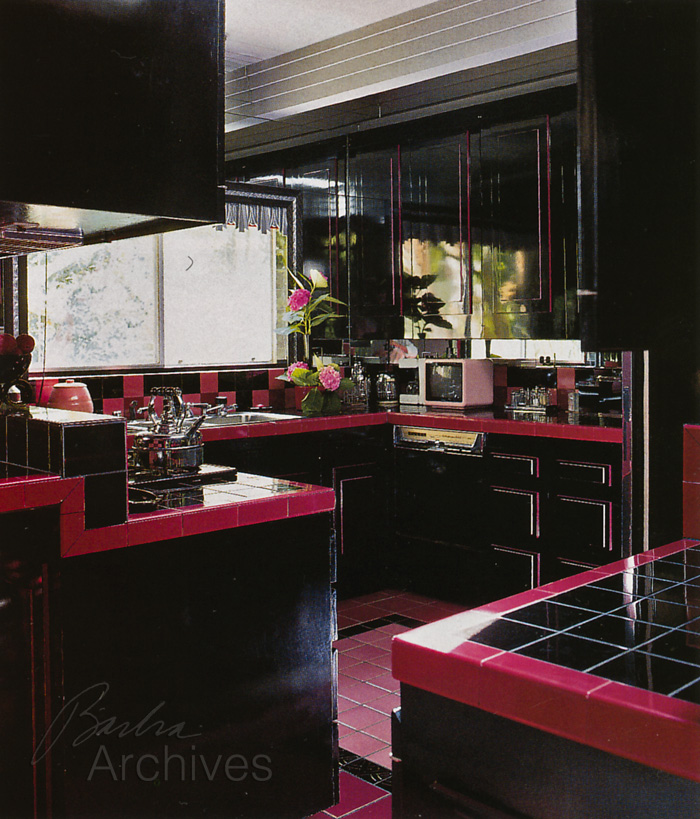
ABOVE: The use of just four colors throughout the house—burgundy, rose, black and gray—extends to the kitchen, where the tilework coordinates with the pinstripes on the cabinets, and to the Bauer dishware.
Still, that didn't stop her from doing a couple of rooms in prints. She calls the study off the living room her “Art Deco Matisse room,” in deference to the artist who so magically juxtaposed pattern on pattern in his paintings. In the room is a Deco sideboard that a previous owner had left out in the rain. Streisand rescued and restored it, and when she decided to use it as a stereo cabinet, she had a pair of speaker cases made. Their carving matches that of the sideboard exactly, and she takes pains to point out how beautifully they are made.
But then craftsmanship is something that Streisand feels passionately about. The house, she says, took nearly five years to complete. “Doing this took me almost a year,” she sighs, pointing to one of a pair of elegant gray silk tassels that hang from the silk-rope handrail in the stairway.
Craftsmanship is also the main reason she loves old things. “Where could you buy shoes like this?” she asks, reaching for a pair of 1920s pink satin evening slippers, part of the wardrobe of vintage clothing that fills the house's closets (color-coordinated with each room, of course).
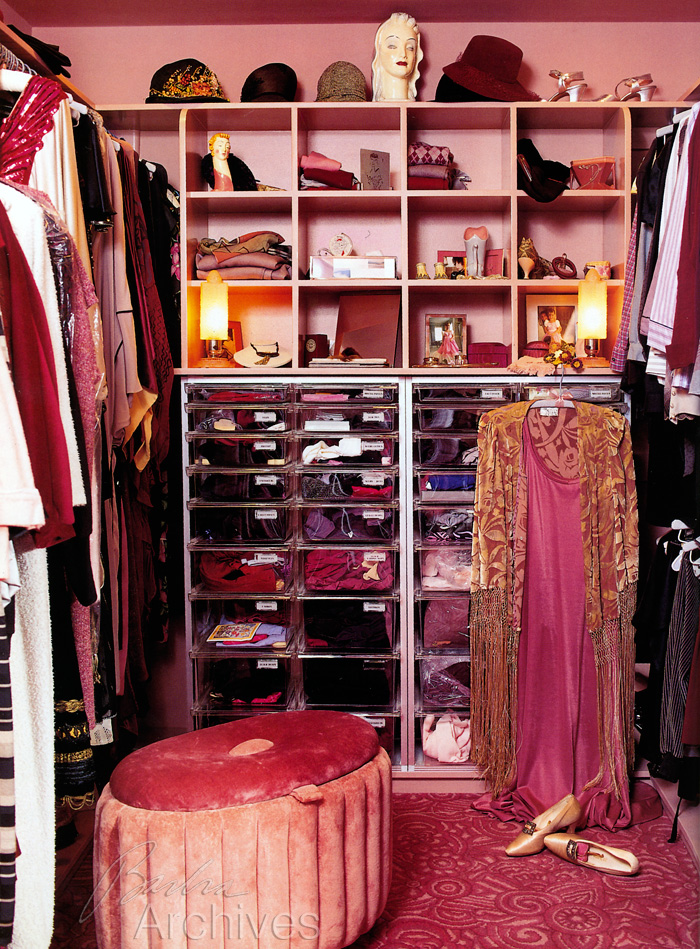
ABOVE: Streisand, who has collected antique clothing for years, recalls wearing the pink satin shoes, on the floor of one of the closets, when she was 18 and appearing at the Bon Soir club in New York. “I wore them with a white-lace- and- pink- ribbon combing jacket, and my mother thought I was singing in my underwear.”
Barbra Streisand began to collect vintage clothes as an aspiring actress because she couldn't afford new ones, but she never stopped appreciating their quality In another closet, Streisand pulls out an ancient, honey-colored coat of karakul with fox trim, for which she paid ten dollars at a thrift shop. “I went to audition for I Can Get It for You Wholesale in that,” she remembers. (The rest is history, and Streisand later had the coat copied exactly, but in white, for her role in Funny Girl on Broadway.)
“Look at that embroidery,” she says, showing off the lining. “It's a wonderful metaphor for life, isn't it? That something should be as beautiful on the inside as it is on the outside—maybe even more beautiful.”
But, as this tireless collector is fond of saying, “I like the idea of evolution and change.” Having focused on American Arts and Crafts furniture, folk art, Pairpoint lamps, and paintings by Thomas Hart Benton and Edward Hopper, Streisand now says, “This time I'm moving back in history—I'm fascinated by eighteenth-century America.” Between study trips to places like Winterthur and Monticello (which inspired her to repaint her Beverly Hills dining room a deep, rich ivory), Streisand is buying everything from primitive paintings and furniture to eighteenth-century American interpretations of Chippendale and Queen Anne.
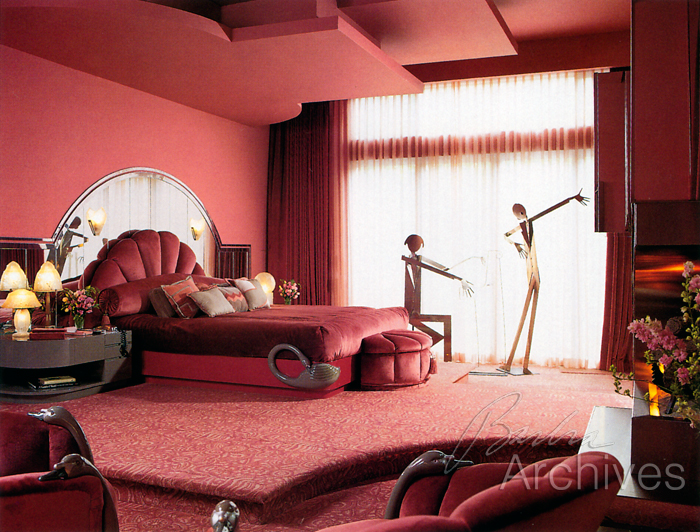
ABOVE: Silhouetted against the velvet draperies in the master bedroom are a pair of chrome figures by Karl Hagenauer. Streisand, who says she "decided to go with asymmetry" in the bedroom, had the stepped ceiling cut into curved shapes on one side and geometric shapes on the other. Fabrics by Clarence House. Carpet by Stark.
To make her vision of Americana complete, Streisand would love to build a new house, “with a lot of porches” and perhaps a grand stair hall, inspired by the historic Colonial and southern houses that she has seen in her travels. However, on top of her new contract with Sony to record six albums and make new films, including an adaptation of Larry Kramer's play The Normal Heart, building a new house may be too much for one person to handle. Then again, Barbra Streisand has only to recall the tag line of her film Yentl (one of the few movies that a woman co-wrote, produced, directed and starred in): “Nothing's impossible.”

ABOVE: The bedroom furniture was designed around a swan motif. “I love ambiguous colors and tastes,” Streisand says. “It's hard to capture the taste of an avocado or the smell of a gardenia. There's no such thing as a gardenia perfume that smells like a gardenia.”
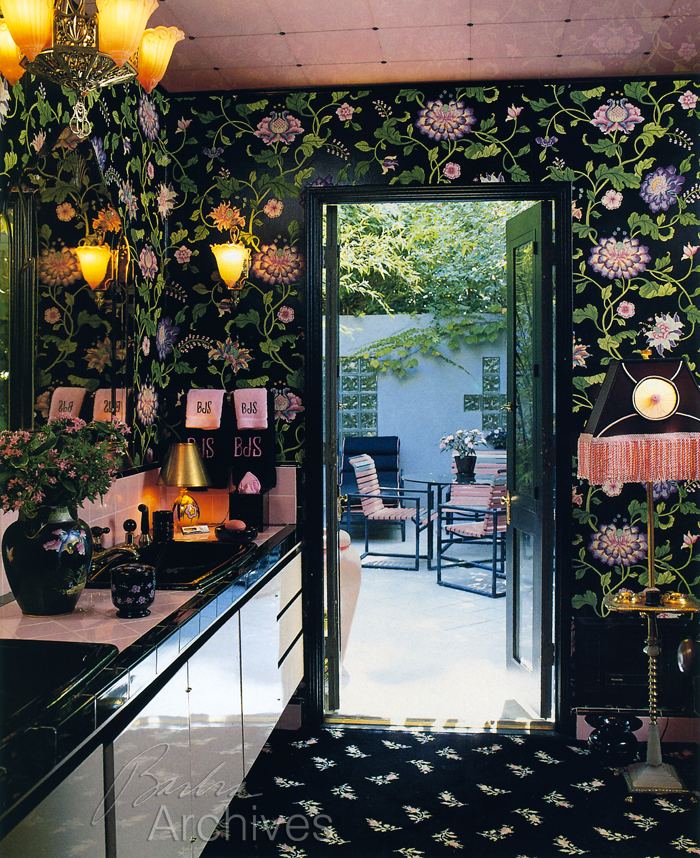
ABOVE: In a departure from the house's strict palette, Streisand used patterns in a first-floor powder room, which has Deco-style light fixtures. Outside, in a small enclosed garden, the patio furniture repeats the pink and gray tones. Wallcovering, Clarence House.

ABOVE: The bar room, converted from a garage, overlooks the lushly landscaped rear garden and swimming pool. The chrome banding on the custom-designed lacquered cabinet is echoed by the pinstripes on the Art Deco-style club chairs. Upholstery fabrics from Brunschwig & Fils and Clarence House.
End.
OUTTAKES
The following photo, shot by John Vaughan, is an alternate of the cover photo, and appeared in Christie's International magazine.
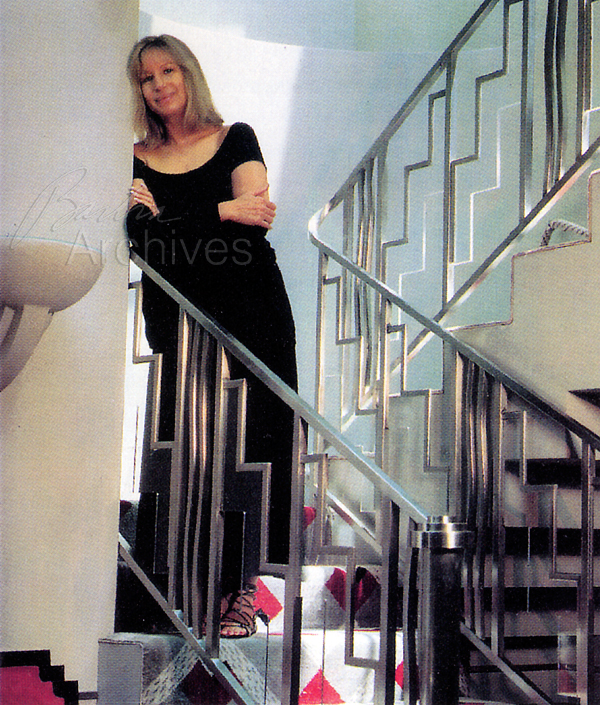
Here's Barbra in a different pose ....
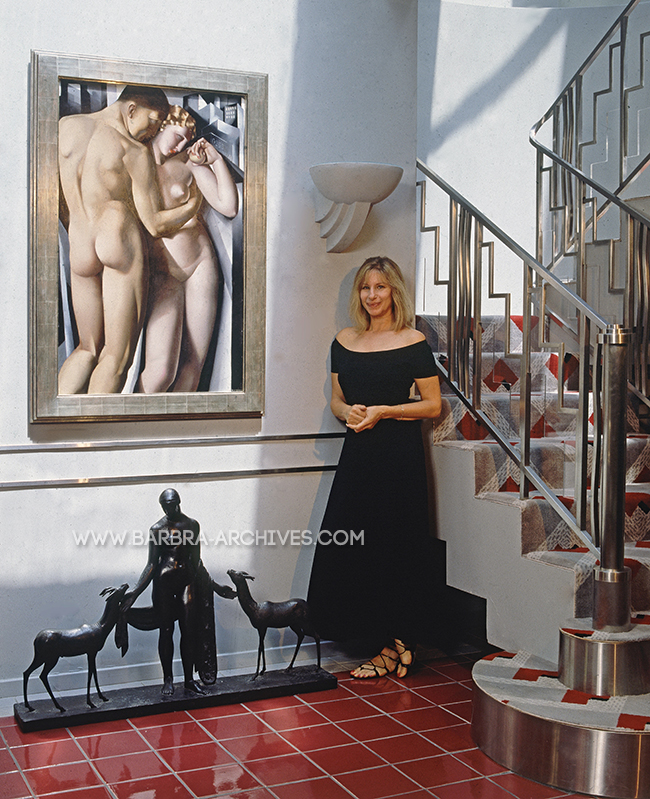
[ top of page ]
